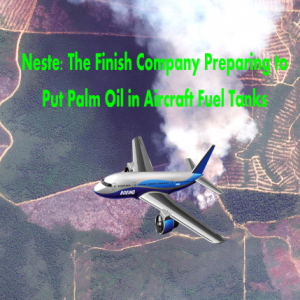Click here to read Biofuelwatch’s report about the Finish biofuel and oil company Neste and its aviation biofuel plans.
Executive Summary:
Neste aims to become the world’s largest aviation biofuel producer in 2019 and to rapidly scale up its production in the next five years. The company is well placed to do so, since it is the world’s biggest producer of biofuels from Hydrotreated Vegetable Oil (HVO), as well as being an existing supplier of aviation fuels (so far primarily fossil fuels). Hydrotreating is the only technology mature enough and within a price range that is feasible for commercial aviation biofuels. Furthermore, Neste has already signed agreements with several airlines and airports to supply HVO aviation biofuels.
Neste relies heavily on palm oil – both crude palm oil and an extract of crude palm oil called palm fatty acid distillate (PFAD). The company has decided to locate its aviation biofuel production in Singapore, i.e. in the centre of the world’s largest palm oil producing region. Neste claims that its crude palm oil is guaranteed to be ‘sustainable’ and ‘deforestation-free’. Even if this was true, the indirect greenhouse gas emissions of palm oil biofuels are still three times as bad for the climate as those of the fossil fuels they replace. Neste can meet EU sustainability standards for biofuels by sourcing palm oil from older plantations, commonly ones for which rainforest was destroyed before 2008. However, investigations show that Neste cannot even guarantee that all its crude palm oil is free from more recent or ongoing deforestation. At least one of the mills supplying Neste was found to have sourced palm oil from illegal plantations inside a national park in Sumatra during three separate investigations, most recently in 2017.
An undisclosed proportion of Neste’s feedstock – very possibly the majority – consists of PFAD which Neste cannot even trace back to plantations. PFAD is diverted from other users who in turn replace their supply mainly with crude palm oil. This means that the impacts on forests and the climate are very similar whether PFAD or crude palm oil is used. Moreover, further increases in PFAD demand could easily make it more expensive than crude palm oil and thus cause it to directly (rather than indirectly as at present), drive the expansion of oil palm plantations. Neste’s description of PFAD as a ‘residue’ is misleading. PFAD is in fact treated as a food-based biofuel under biofuel legislation in several European countries.

